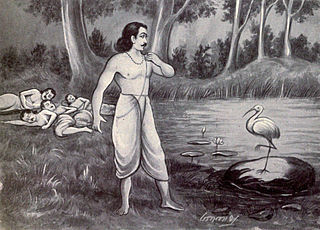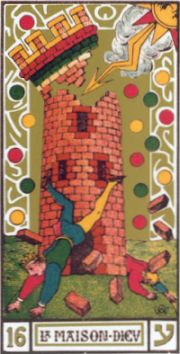Mahabharata
After the common youth the Kauravas and the Pandavas split up. Later they meet in Kurukshetra as opposing armies. Krishna stands here as leader of Arjuna in the center of attention.
The Texts is divided into 18 books(parvas). Chapters 25-42 of Book 6 Bhishma Parva contain the Bhagavad Gita.
| Parva | Title | Sub-parvas | Contents |
|---|---|---|---|
| 1 | Adi Parva (The Book of the Beginning) | 1–19 | How the Mahābhārata came to be narrated by Sauti to the assembled rishis at Naimisharanya, after having been recited at the sarpasattra of Janamejaya by Vaishampayana at Takṣaśilā. The history and genealogy of the Bharata and Bhrigu races is recalled, as is the birth and early life of the Kuru princes (adi means first). |
| 2 | Sabha Parva (The Book of the Assembly Hall) | 20–28 | Maya Danava erects the palace and court (sabha), at Indraprastha. Life at the court, Yudhishthira's Rajasuya Yajna, the game of dice, the disrobing of Pandava wife Draupadi and eventual exile of the Pandavas. |
| 3 | Vana Parva also Aranyaka-parva, Aranya-parva (The Book of the Forest) | 29–44 |
The twelve years of exile in the forest (aranya) : They are an allegory of step 7 and 8 of the universal path. |
| 4 | Virata Parva (The Book of Virata) | 45–48 | The year spent incognito at the court of Virata. |
| 5 | Udyoga Parva (The Book of the Effort) | 49–59 | Preparations for war and efforts to bring about peace between the Kaurava and the Pandava sides which eventually fail (udyoga means effort or work). |
| 6 | Bhishma Parva (The Book of Bhishma) | 60–64 | The first part of the great battle, with Bhishma as commander for the Kaurava and his fall on the bed of arrows. (Includes the Bhagavad Gita in chapters 25-42.) |
| 7 | Drona Parva (The Book of Drona) | 65–72 | The battle continues, with Drona as commander. This is the major book of the war. Most of the great warriors on both sides are dead by the end of this book. |
| 8 | Karna Parva (The Book of Karna) | 73 | The continuation of the battle with Karna('ear') as commander of the Kaurava forces. |
| 9 | Shalya Parva (The Book of Shalya) | 74–77 | The last day of the battle, with Shalya('pointed wapon') as commander. Also told in detail, is the pilgrimage of Balarama to the fords of the river Saraswati and the mace fight between Bhima and Duryodhana which ends the war, since Bhima kills Duryodhana by smashing him on the thighs with a mace. |
| 10 | Sauptika Parva (The Book of the Sleeping Warriors) | 78–80 | Ashvattama, Kripa and Kritavarma kill the remaining Pandava army in their sleep. Only 7 warriors remain on the Pandava side and 3 on the Kaurava side. |
| 11 | Stri Parva (The Book of the Women) | 81–85 | Gandhari and the women (stri) of the Kauravas and Pandavas lament the dead and Gandhari cursing Krishna for the massive destruction and the extermination of the Kaurava. |
| 12 | Shanti Parva (The Book of Peace) | 86–88 | The crowning of Yudhishthira as king of Hastinapura, and instructions from Bhishma for the newly anointed king on society, economics and politics. |
| 13 | Anushasana Parva (The Book of the Instructions) | 89–90 | The final instructions (anushasana) from Bhishma. |
| 14 | Ashvamedhika Parva (The Book of the Horse Sacrifice)[27] | 91–92 | The royal ceremony of the Ashvamedha (Horse sacrifice) conducted by Yudhishthira. The world conquest by Arjuna. The Anugita is told by Krishna to Arjuna. |
| 15 | Ashramavasika Parva (The Book of the Hermitage) | 93–95 | The eventual deaths of Dhritarashtra, Gandhari and Kunti in a forest fire when they are living in a hermitage in the Himalayas. Vidura predeceases them and Sanjaya on Dhritarashtra's bidding goes to live in the higher Himalayas. |
| 16 | Mausala Parva (The Book of the Clubs) | 96 | The materialisation of Gandhari's curse, i.e., the infighting between the Yadavas with maces (mausala) and the eventual destruction of the Yadavas. |
| 17 | Mahaprasthanika Parva (The Book of the Great Journey) | 97 | The great journey of Yudhishthira, his brothers and his wife Draupadi across the whole country and finally their ascent of the great Himalayas where each Pandava falls except for Yudhishthira. |
| 18 | Svargarohana Parva (The Book of the Ascent to Heaven) | 98 | Yudhishthira's final test and the return of the Pandavas to the spiritual world (svarga). |
| khila | Harivamsa Parva (The Book of the Genealogy of Hari) | 99–100 | This is an addendum to the 18 books, and covers those parts of the life of Krishna which is not covered in the 18 parvas of the Mahabharata. |
==Allegory ==
The Mahabharata contains - besides further storys like "Savitri" - the life of the Pandavas as a parable of the path.
The Pandavas are sons of Pandu, the King of Hastinapur and his two wives Kunti and Madri. They represent the 5 chakras and their respective elements. They are also considered as five aspects of Shiva.
They grow up together with the Kauravas and leave Drupada's court together with their common wife Draupadi at the end of step 6.
Draupadi was the fire-born daughter of Drupada. She represents the fiery Kula-Kundalini. Arjuna was able to win her by mastering the bow which Agni gave him, comparable to Rama in the Ramayana, who won Sita because he was able t o strech Shivas bow.
o strech Shivas bow.
In the woods they encounter Yama in his disguise as a Raksha-crane, whose questions only Yudhisthira can answer(U.Path 7.2) - similar to Oedipus and the Sphinx.
The burning Khandava forest is here an allegorie of the final fiery purification of the pranas(U.Path 8.3), which have their origin in the prana-kundalini. The trees are like the prana - snakes and nadis near to the material world (or body)....
During a first battle with the Kauravas, Arjuna can destroy the crown of king Duryodhana (eqivalent to step 16 of the path).
The final battle at Kurukshetra happens during the phase 18.2 of the universal path - with the result of the Nirvikalpa-Samadhi.
Finally only king Yudhisthira as carrier of divine consciousness survives and reaches Sahaj-Samadhi (step 19 of the U.Path).
== Literature ==
- Archive.org : Suche : Mahabharata
- Mahabharata, P. Ch. Roy - 12 volumes
- The Mahabharata - by Vyha, Krishna dwaipayana, 1925
- Mahabharata of Ramanarayanadatta astri, Hindi with pictures
== Links ==
- Wiki about the Mahabharata
- Mahabharata criticism, Vaidya, C. A. , 1905
- Symbolism of the Mahabharata
- Symbolism of Mahabharata charcters
- Indiatimes : Mahabharata has a deep underlying symbolism
- Sri Aurobindo about Mahabharata and Ramayana
Archive : The Mahabharata
of Spirituality
universal-path.org